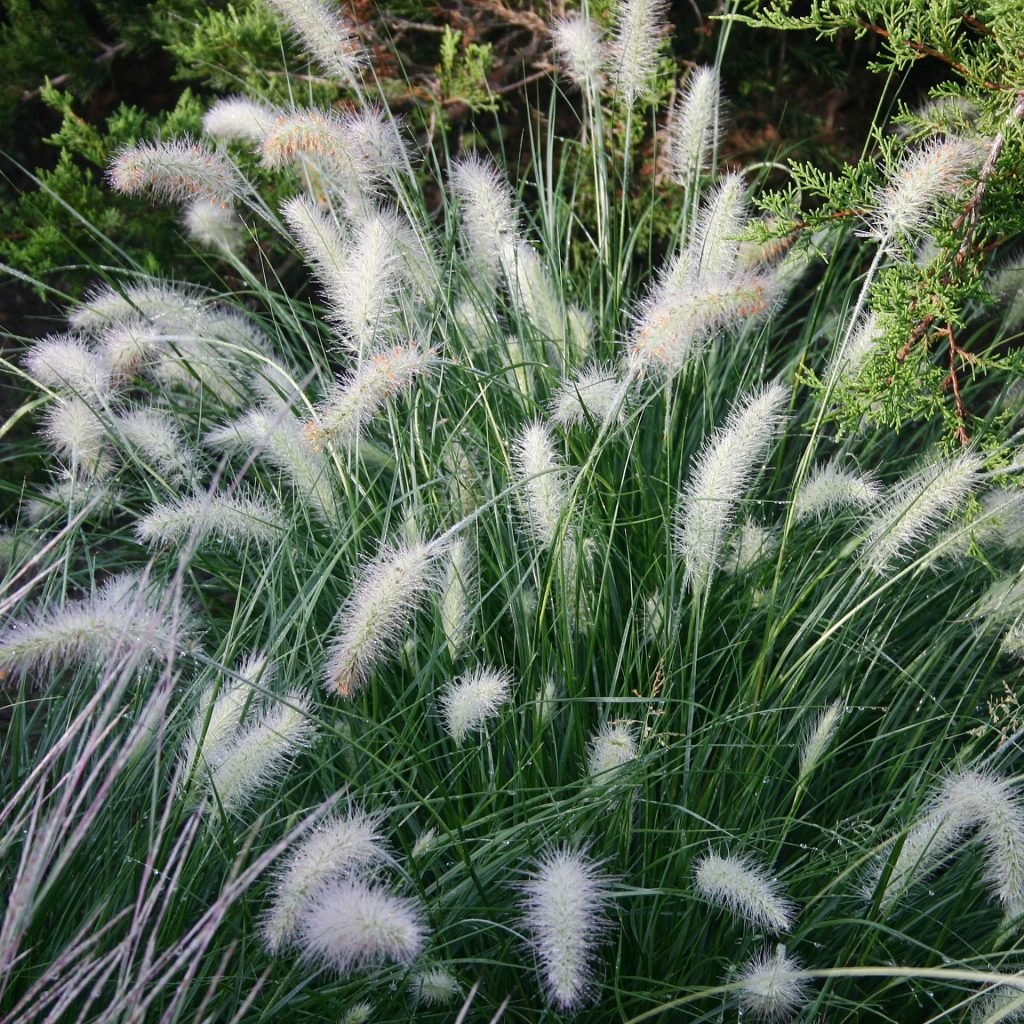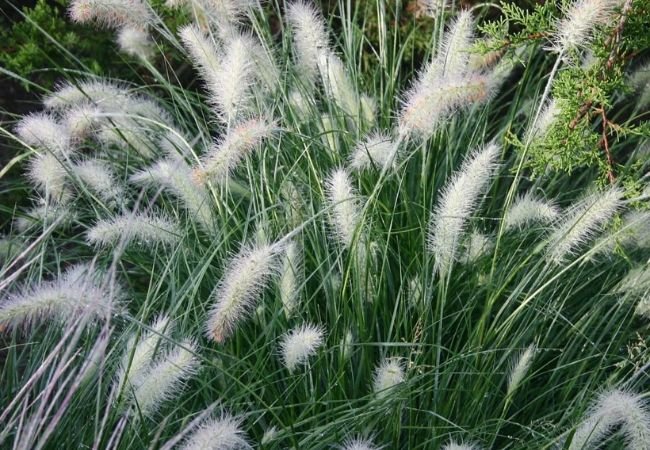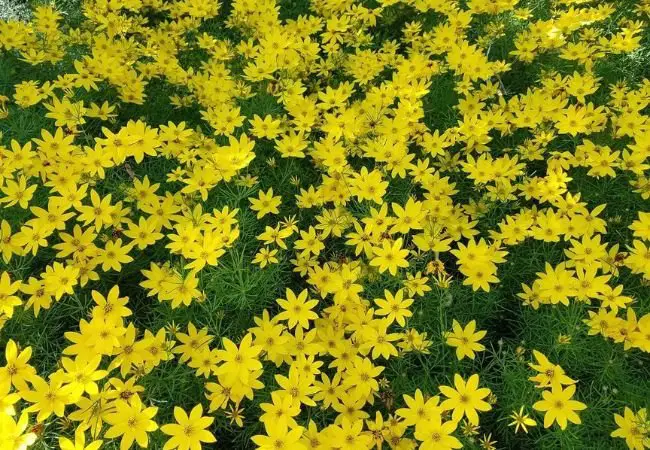Learn how to grow and care for White Fountain Grass (Pennisetum Setaceum). Discover tips for planting, maintenance, and incorporating this elegant ornamental grass into your landscape.
White Fountain Grass, scientifically known as Pennisetum setaceum ‘Alba’, is a stunning ornamental grass that can add elegance and movement to any garden. With its graceful, arching form and fluffy white plumes, it’s a popular choice for both modern and traditional landscapes. This guide will walk you through everything you need to know about growing and caring for White Fountain Grass.
Here is a chart with detailed information on White Fountain Grass:
| Category | Information |
|---|---|
| Botanical Name | Pennisetum setaceum ‘Alba’ |
| Common Name | White Fountain Grass |
| Plant Type | Perennial Ornamental Grass (Grown as Annual in Cooler Climates) |
| Hardiness Zone | 9-10 (Perennial); 6-8 (Annual) |
| Sun Exposure | Full Sun |
| Soil Type | Well-drained, Sandy or Loamy Soil |
| Watering | Moderate, Drought Tolerant Once Established |
| Growth Habit | Clumping, Arching Foliage |
| Height/Spread | 2-3 feet tall / 2-3 feet wide |
| Flowering Time | Late Summer to Fall |
| Flower Description | Creamy White, Feathery Plumes |
| Special Features | Showy Plumes, Drought Tolerant, Low Maintenance, Adds Movement and Texture to Gardens, Ideal for Borders and Containers |
Understanding White Fountain Grass

Before we dive into care instructions, let’s get to know this beautiful plant:
- Scientific name: Pennisetum setaceum ‘Alba’
- Common names: White Fountain Grass, White African Fountain Grass
- Plant type: Ornamental grass
- Height: 3-5 feet (90-150 cm)
- Spread: 2-4 feet (60-120 cm)
- Bloom time: Late summer to fall
- USDA Hardiness Zones: 8-11
White Fountain Grass is a variety of the popular Purple Fountain Grass, featuring white plumes instead of purple ones. It’s known for its graceful, fountain-like shape and its ability to add movement and texture to gardens.
Planting White Fountain Grass
Proper planting is crucial for the health and growth of your White Fountain Grass. Here’s what you need to know:
When to Plant
- Spring is the best time to plant White Fountain Grass
- In warmer climates, it can also be planted in fall
Where to Plant
- Choose a location with full sun to partial shade
- Ensure the area has well-draining soil
- Allow enough space for the plant to reach its full size
How to Plant
- Dig a hole twice the width of the root ball
- Place the plant in the hole at the same depth it was in its container
- Backfill with soil and water thoroughly
- Apply a layer of mulch around the base, keeping it away from the stems
Caring for White Fountain Grass
White Fountain Grass is relatively low-maintenance, but proper care will ensure it thrives:
Watering
- Water regularly during the first growing season to establish a deep root system
- Once established, White Fountain Grass is drought-tolerant
- Water deeply during extended dry periods
Fertilizing
- Apply a balanced, slow-release fertilizer in spring
- Avoid over-fertilizing, as this can lead to excessive growth and floppy stems
Pruning
- Cut back the grass to about 6 inches above the ground in late winter or early spring
- This encourages fresh growth and maintains the plant’s shape
- Wear gloves when pruning, as the leaves can be sharp
Winter Care
- In colder regions (Zones 6-7), provide winter protection by mulching heavily around the base
- In very cold areas, consider growing White Fountain Grass as an annual or in containers that can be moved indoors
Common Problems and Solutions
While White Fountain Grass is generally hardy, it can face some issues:
Pest Problems
- Aphids and spider mites can occasionally be a problem
- Treat with insecticidal soap or neem oil if infestations occur
Diseases
- Root rot can occur in poorly-draining soil
- Prevent by ensuring good drainage and avoiding overwatering
Invasive Potential
- In some areas, Fountain Grass can be invasive
- Check local regulations before planting
- Consider planting in containers to control spread
Landscaping with White Fountain Grass
White Fountain Grass is versatile and can be used in various ways in your landscape:
As a Focal Point
- Plant a single specimen in a prominent location
- Its graceful form and white plumes make it an excellent focal point
In Mass Plantings
- Create a dramatic effect by planting in large groups
- This works well in modern landscapes or as a natural privacy screen
In Mixed Borders
- Combine with other perennials and shrubs for a diverse garden
- The white plumes contrast beautifully with colorful flowers
In Containers
- Grow in large containers for a striking patio or balcony display
- Pair with trailing plants for added interest
Companion Plants
White Fountain Grass pairs well with many plants, including:
- Black-Eyed Susan (Rudbeckia)
- Purple Coneflower (Echinacea)
- Sedum
- Lavender
- Ornamental grasses with contrasting colors or textures
Seasonal Interest
White Fountain Grass provides year-round interest:
- Spring: Fresh green growth emerges
- Summer: Foliage reaches full height
- Fall: Fluffy white plumes appear
- Winter: Dried plumes and foliage add texture to the winter garden
Propagation
You can propagate White Fountain Grass by division:
- Divide the plant in spring just as new growth begins
- Dig up the entire clump and separate it into smaller sections
- Replant the divisions immediately and water well
Environmental Benefits
White Fountain Grass isn’t just beautiful; it also offers environmental benefits:
- Attracts birds, who use the grass for nesting material and seeds for food
- Provides shelter for small wildlife
- Helps prevent soil erosion with its robust root system
White Fountain Grass is a stunning and versatile ornamental grass that can enhance any garden or landscape. With its elegant white plumes and graceful form, it adds movement, texture, and visual interest throughout the seasons. By following the planting and care instructions in this guide, you can enjoy the beauty of White Fountain Grass in your own garden.
Remember, while it’s relatively low-maintenance, paying attention to its basic needs – like proper watering, annual pruning, and appropriate placement – will ensure your White Fountain Grass thrives and remains a beautiful feature in your landscape for years to come.
Whether you’re looking to create a focal point, add texture to mixed borders, or simply enjoy the graceful movement of ornamental grasses, White Fountain Grass is an excellent choice. Its ability to adapt to various garden styles and its striking appearance make it a favorite among gardeners and landscape designers alike.
For more gardening tips and plant care guides, visit usagardenhub.com







One comment on “White Fountain Grass : Growing and Caring for Pennisetum Setaceum”